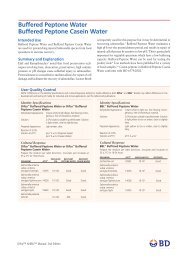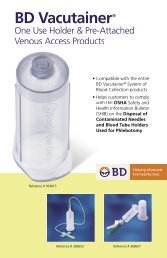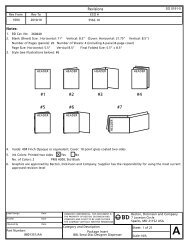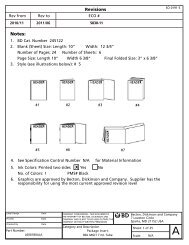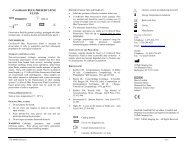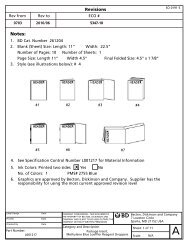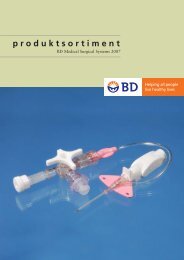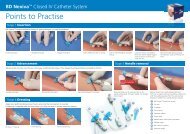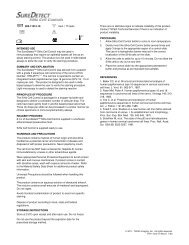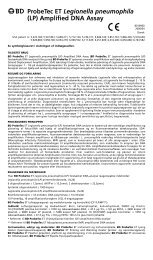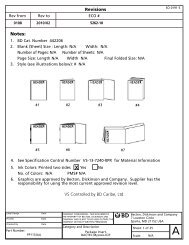BBL Coagulase Plasmas - BD
BBL Coagulase Plasmas - BD
BBL Coagulase Plasmas - BD
You also want an ePaper? Increase the reach of your titles
YUMPU automatically turns print PDFs into web optimized ePapers that Google loves.
� <strong>BBL</strong> <strong>Coagulase</strong> <strong>Plasmas</strong><br />
� 8810061JAA<br />
2010/07<br />
English: pages 1 – 4 Italiano: pagine 9 – 12<br />
Français : pages 4 – 6 Español: páginas 12 – 15<br />
Deutsch: Seiten 6 – 9<br />
INTENDED USE<br />
<strong>BBL</strong> <strong>Coagulase</strong> Plasma, Rabbit and <strong>BBL</strong> <strong>Coagulase</strong> Plasma, Rabbit with EDTA are<br />
used to qualitatively determine the pathogenicity of staphylococci using the direct<br />
tube method.<br />
SUMMARY AND EXPLANATION<br />
Identification of staphylococci is based on microscopic examination, colonial<br />
morphology and cultural and biochemical characteristics. Staphylococci associated<br />
with acute infection (Staphylococcus aureus in humans and S. intermedius and<br />
S. hyicus in animals) can clot plasma. The most widely used and generally accepted<br />
criterion for identification of these pathogenic organisms is based on the presence<br />
of the enzyme coagulase. 1 The ability of Staphylococcus to produce coagulase was<br />
first reported by Loeb2 in 1903.<br />
<strong>Coagulase</strong> binds plasma fibrinogen, causing the organisms to agglutinate or plasma<br />
to clot. Two different forms of coagulase can be produced, free and bound. Free<br />
coagulase is an extracellular enzyme produced when the organism is cultured in<br />
broth. Bound coagulase, also known as clumping factor, remains attached to the cell<br />
wall of the organism. The tube test can detect the presence of both bound and free<br />
coagulase. Isolates that do not produce clumping factor must be tested for the<br />
ability to produce extracellular coagulase (free coagulase).<br />
<strong>BBL</strong> <strong>Coagulase</strong> Plasma, Rabbit and <strong>BBL</strong> <strong>Coagulase</strong> Plasma Rabbit with EDTA are<br />
recommended for performing the direct tube test. The inoculum used for testing<br />
must be pure because a contaminant may produce false results after prolonged<br />
incubation. For the coagulase test, <strong>BBL</strong> <strong>Coagulase</strong> Plasma, Rabbit with EDTA is<br />
superior to citrated plasma because citrate-utilizing organisms such as Pseudomonas<br />
species, Serratia marcescens, Enterococcus faecalis and strains of Streptococcus will<br />
clot citrated plasma in 18 h. 3<br />
PRINCIPLES OF THE PROCEDURE<br />
S. aureus produces two types of coagulase, free and bound. Free coagulase is an<br />
extracellular enzyme produced when the organism is cultured in broth. Bound<br />
coagulase, also known as the clumping factor, remains attached to the cell wall of<br />
the organism.<br />
In the direct tube test, free coagulase liberated from the cell acts on prothrombin in<br />
the coagulase plasma to give a thrombin-like product. This product then acts on<br />
fibrinogen to form a fibrin clot. 4<br />
The tube test is performed by mixing an overnight broth culture or colonies from a<br />
non-inhibitory agar plate into a tube of rehydrated coagulase plasma. The tube is<br />
incubated at 37°C. The formation of a clot in the plasma indicates coagulase<br />
production.<br />
REAGENTS<br />
<strong>Coagulase</strong> Plasma, Rabbit is lyophilized rabbit plasma with 0.85% sodium citrate and<br />
0.85% sodium chloride, approximately.<br />
<strong>Coagulase</strong> Plasma, Rabbit with EDTA is lyophilized rabbit plasma with 0.15% EDTA<br />
(ethylenediaminetetraacetic acid) and 0.85% sodium chloride, approximately.<br />
Warnings and Precautions<br />
For in vitro Diagnostic Use.<br />
The Packaging of This Product Contains Dry Natural Rubber.<br />
Observe aseptic technique and established precautions against microbiological<br />
hazards throughout all procedures. After use, specimens, containers, slides, tubes<br />
and other contaminated material must be sterilized by autoclaving.<br />
Directions for use should be followed carefully.<br />
Storage<br />
Store unopened lyophilized <strong>BBL</strong> <strong>Coagulase</strong> Plasma, Rabbit and <strong>BBL</strong> <strong>Coagulase</strong><br />
Plasma, Rabbit with EDTA at 2 – 8°C.<br />
Store reconstituted plasma at 2 – 8°C for up to 14 days, or aliquot and freeze promptly<br />
at -20°C for up to 30 days. Do not thaw and refreeze.<br />
Expiration date applies to product in its intact container when stored as directed. Do<br />
not use if the product is caked, discolored or shows other signs of deterioration.<br />
Examine reconstituted reagents for evidence of contamination, evaporation or other<br />
signs of deterioration, such as cloudiness or partial clotting.<br />
SPECIMEN COLLECTION AND PREPARATION<br />
Collect specimens or samples in sterile containers or with sterile swabs and transport<br />
immediately to the laboratory according to recommended guidelines. 1,4-9<br />
Process each specimen using procedures appropriate for that sample. 1,4-9




